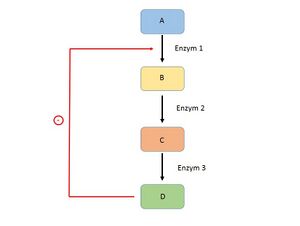Basics of the regulation of metabolic pathways
The regulatory reaction of a specific metabolic pathway is usually localized at its beginning – typically it is the first irreversible step. The reason for this is to limit the waste of resources and the unnecessary production of intermediates that would occur if the track stopped in the middle instead of at its beginning.
The regulatory enzyme is usually present in a low concentration that limits it. It is an allosteric enzyme working on the principle of all or nothing. For regulation, it is advantageous if there is a sort of concentration limit above which the reaction starts and quickly reaches maximum speed, and vice versa, below which the reaction hardly takes place.
The feedback principle is applied in the regulation of metabolic pathways. It is a feedback effect on the course of the reaction from the created intermediates or the final product. We distinguish between two types of feedback:
- negative feedback,
- positive feedback.
Negative Feedback[edit | edit source]
It leads to a sequence of reactions in which the system returns to its original value. This is the source of stability of the system, which constantly returns to the value of the set point, the set value. Negative feedback is therefore part of most pathways.
Positive Feedback[edit | edit source]
It leads to a series of reactions that deepen it even more. There is, however, a risk of a vicious circle (circulus vitiosus). Each further increase in deviation accelerates its increase until finally the instability of the system causes its collapse.
Regulatory step affects[edit | edit source]
Change in Absolute Enzyme Concentration (amount of Eezyme)[edit | edit source]
The process of transcription and translation is affected, namely the induction (activation) or repression (inhibition) of the expression of the gene encoding the given enzyme. An example is substrate induction, where the presence of a substrate induces enzyme synthesis.
Modulation of the activity of an already existing enzyme (enzyme activity)[edit | edit source]
- the presence of activators / inhibitors,
- covalent modification of the enzyme molecule (phosphorylation / dephosphorylation, formation of active enzymes from proenzymes, ...).

